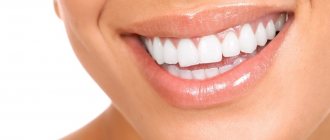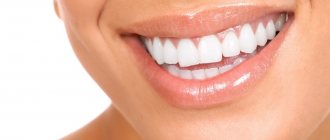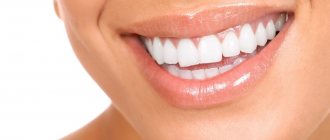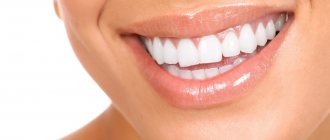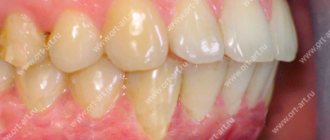A smiling person is more successful than one who constantly frowns and keeps his lips pursed in displeasure. This statement has long been proven by a number of sociological surveys and statistics. But what if a person frowns and smiles not because he is constantly in a bad mood, but because he considers his smile ugly and is embarrassed by it?
People are embarrassed about their own smile for various reasons, but most often due to some kind of dental problem. Caries, darkened fillings, chips on teeth, yellowness, unattractive shape of teeth - all this negatively affects the aesthetics of a smile and forces us to hide it. But all these problems are solvable and correctable; modern dentistry is capable of giving anyone a perfect, Hollywood smile.
What dental technologies help create the perfect smile and how much does it cost to make your smile Hollywood? We will tell you about this in detail in our article.
Some terminology
The arrangement of the lower and upper teeth in relation to each other is called the bite. There is a similar concept - occlusion, which refers to the natural closure of the jaws. This is a process where the masticatory muscles, teeth, and temporomandibular joints take part. There are central, anterior and lateral clutches of the jaws. Central occlusion, in essence, is a bite. If it is correct, it is called physiological; if not, it is called abnormal or pathological. With normal occlusion, the functions of chewing and speech are not impaired. With pathology, it’s the opposite.
Teeth color
The patient, doctor and dental technician take part in choosing the color of the teeth. This is how you can get the result that a patient expects when visiting a dentist for dental prosthetics. The Family Dental Clinic has its own dental laboratory, and dental technicians can take a direct part in discussing the type of future dentures, as well as use photographs of the patient from the Center’s database in the manufacture of denture structures.
Why is correct bite important?
Correct occlusion is an important component of a person’s full life. With various types of curvature of the teeth, their disproportionate location, a person experiences psychological discomfort - difficulties arise in communication, a career does not work out, and so on. But with pathological occlusion, problems that lead to disruptions in the functioning of the entire organism become more significant.
- Jaws that do not close properly make it difficult to chew food. In this form, it is poorly processed, which provokes diseases of the digestive system.
- With abnormal occlusion, different jaws are affected unevenly. There is a high probability of abrasion, damage, and loss of teeth.
- Improper closing of the jaws creates a large load on the temporal joint, and the jaw muscles do not relax. This can cause regular headaches.
It happens that malocclusions cause displacement of the upper cervical vertebrae, cerebrovascular accidents, and narrowing of the airways, leading to respiratory arrest during sleep.
Interincisal angles.
Interincisal angles are the spaces between the cutting edges of the anterior group of teeth.
Read also: Allergy to arsenic in the tooth symptoms
With the harmonious construction of teeth, these angles should gradually increase from the center to the periphery: from a small closed angle between the central incisors, to a more direct and even open angle between the 2nd and 3rd teeth.
Tooth wear leads to a decrease or complete absence of interincisal angles, which makes the patient look older when he smiles.
At the same time, “female” teeth are characterized by rounded corners of the incisors, while “male” teeth are characterized by straighter ones.
What is the correct bite?
Often the special structure of teeth is mistaken for an anomaly. The main indicators of a correct physiological bite are the complete closure of the jaws, the absence of significant gaps between the teeth and the passage of the center line of the face between the incisors of both rows. There are several types of correct bite:
- Orthognathic is an ideal bite if the teeth are straight and there are no gaps (diastemas) between the lower and upper incisors. Here the upper row overlaps the lower teeth slightly, no more than 30%. Normally, the overlap should be 2-3 mm. This tooth structure is very rare.
- Direct – a borderline state between normality and anomaly. In a person with such a jaw structure, there is no overlap of the dentition on each other: the incisors touch with their apices, the arrangement of the arches is parallel. The negative consequences of this condition include wear of the front teeth due to the increased load on their cutting surface.
- Some people classify progenic bite as malocclusion: with the jaws tightly closed, the lower jaw is slightly pushed forward, although the front teeth of the lower row do not overlap the upper ones. The temporomandibular joint functions normally.
- Biprognathic - when both rows of teeth are slightly tilted forward towards the lips. This occlusion is especially noticeable when looking at the jaws from the side.
- Opisthognathic – inclination of the dentition into the mouth. In this case, the front teeth look very straight.
All types of correct bite generally ensure a harmonious appearance and full functioning of the dental system. However, according to statistics, the number of people with ideally correct structure of teeth and jaws ranges from 10 to 20%.
Aesthetic dentistry. 10 signs of a perfect smile.
If you want to improve the appearance of your smile, if you don’t like something about it, but you cannot accurately and correctly formulate what exactly, if you want to talk with your dentist about the aesthetics of your smile in the same language, then the following note is just right for you.
Nature (or God... depending on your views on life) has made us different. And our originality and uniqueness have its own charm. But what to do when this uniqueness goes too far beyond our ideas of beauty? How to formulate your claims to nature (and perhaps to the previous intervention of dentists)? To assess the aesthetic component of our face, lips, teeth - everything that gives rise to a beautiful, harmonious smile, it turns out that there are many parameters. This is what dentists use (at least should use) when planning changes in your appearance. Since there are very, very many different nuances, and I do not have the task of making each of you an expert in the field of aesthetic dentistry , we will focus on the ten simplest and most important.
Read also: What color is arsenic?
Self-diagnosis
The presence or absence of an anomaly can be determined independently. You need to stand in front of the mirror, swallow and naturally close your teeth. The jaw line normally looks like this:
- There is no gap between the rows - the teeth are in close contact with each other.
- The imaginary vertical lines between the lower and upper incisors coincide.
- The upper row overlaps the lower teeth by a maximum of a third of the height.
- The cutting edge of the lower incisors is in contact with the palatal cusps of the upper ones.
- During chewing movements, the molars do not lose contact with each other.
- The upper dental arch, similar to a semi-oval, is larger than the lower one and is inclined slightly towards the mouth. The lower one is similar to a parabola and is directed towards the larynx.
Sometimes it is difficult to distinguish between normal and pathological. An orthodontist can assess the state of the structure of the dental system.
When should the situation be corrected?
There are often cases when, with a normal physiological occlusion, it is necessary to carry out correction. Direct occlusion leads to tooth wear, and progenic and biprognathic bites can cause aesthetic discomfort, for example, when the upper lip is very short, exposing the front teeth, or when they are large and unsightly.
Abnormal types of closure with obvious defects require mandatory correction, since such pathologies interfere with the normal functioning of the jaws, have a negative effect on the body, and distort the proportions of the face.
There are several pathological levels:
- Violation of the shape, position and number of teeth.
- The size of the dentition is increased or decreased.
- Abnormal positions and sizes of the jaw bones.
The severity of the pathology is influenced by the area and degree of deformation of the constituent elements of the dental system. Therefore, when identifying an abnormal bite, it is important not only to identify the defect, but also to establish the reasons for its development.
Aesthetic parameters
In addition to the above, much attention is paid directly to the aesthetic shape of the teeth. It depends on the proportions of the face. Thus, when making prosthetics, the parameters of the proportional relationship between the face and teeth are taken into account. In particular, when designing the crowns of the anterior teeth, the parameters according to V.A. Pereverzev are used, which can be found below:
No less significant in dentistry is the Fibonacci number or the so-called “golden ratio” rule. As you know, many “golden” proportions can be found in the structure of the human body. As it turned out, the rule of the “golden ratio” is also observed in relation to the human dental system. For the first time, a dentist from the USA, Robert Ricketts, was involved in systematizing knowledge in this area. As you know, the “golden ratio” is a ratio of 1 to 1.618. Ricketts determined that the ratio of the width of the upper central incisor to the width of the lower one is precisely the ratio of 1 to 1.618. Moreover, this is not the only coincidence. This proportion is observed when comparing the width of the lower incisors and the six anterior teeth of the upper jaw and many other measurements.
When forming incisors, they also use the 1 to 16 rule. For example, this rule is decisive when determining the height and width of the central incisor. The height is 1/16 of the straight line connecting the pupils and the base of the chin, and its width is 1/16 of the line connecting the cosmetic center of the face and the protrusion of the cheekbone.
Read also: Which side does the wisdom tooth grow on?
The shape of the teeth also determines the masculinity and femininity of the face. It has been noticed that the second incisors in the female version are more rounded, while the male ones have a more rectangular shape. Rounded fangs give the face a more benevolent expression, sharp fangs give it an aggressive expression.
Undoubtedly, modern dentists take all of the above into account when creating dentures. However, some patients do not like a too perfect smile and then the denture is deliberately “decorated” with defects.
When preparing this article, information was used: from here.
Types of anomalies
Correct bite is a fairly rare occurrence. Much more often you can meet people with one or another anomaly that needs to be corrected.
- Distal or prognathic bite is an excessive protrusion of the upper jaw. The lower jaw is underdeveloped.
- Medial, or mesial - bite with advancement of the mandibular bone. There is overlap of the upper crowns with the lower teeth.
- With an open bite, there is no closure of the teeth. Diastemas can be on the side or between the elements of the anterior group.
- Deep bite – significant (more than 60%) coverage of the upper incisors by the lower incisors. This anomaly has another name - “traumatic” bite, since the gums and palate are often damaged during chewing.
- A crossbite in which the jaws intersect diagonally like scissors.
- A low bite develops as a result of teeth grinding against each other or after they fall out.
People with improper occlusion often experience an asymmetrical oval of the face in the lower part, speech defects (usually a lisp), and unpleasant sensations in the temples during chewing movements. Significant plaque deposits on some teeth can also be a result of abnormal jaw closure. This occurs due to uneven load on individual teeth during chewing movements.
Formation of the correct bite
The bite is formed from birth, and the process lasts up to 15 years. Development occurs in stages, from the moment the first primary incisors appear. After changing all the elements, the bite becomes permanent. Its formation is directly influenced by both hereditary and external factors.
In childhood, it is important to pay increased attention to the prevention of the development of correct bite, so that the jaw bones and teeth alignment correspond to the physiological norm. For proper bite development it is necessary:
- Keep your baby breastfed from birth;
- Try not to accustom your baby to a pacifier and pacifier. If this does not work, use rubber as little as possible;
- Avoid developing bad habits such as sucking fingers and toys. When this cannot be avoided, by the age of two the child should be weaned from harmful actions.
- During sleep, the child's mouth should be closed and the head should not be thrown back.
- From the beginning of the growth of baby teeth, it is necessary to include solid foods in the diet.
Pathologies in the development of the dental system can occur with rickets, dyspepsia, and tuberculosis. It is also necessary to pay attention to ENT diseases.
Oral hygiene is an important condition for the development of correct bite. You should treat baby teeth in a timely manner and try to ensure that they last their intended time. Irregular teeth replacement can cause the development of pathology. It is unacceptable for permanent teeth to occupy niches with milk teeth that have not yet fallen out.
Interesting facts about facial expressions
It is the face of the interlocutor, and not his words, that often reveals what he is really thinking about. Facial expressions can show how sincere a person is in his statements, for example:
- The more false a person’s speech and his emotions are, the more asymmetry of facial expressions will appear on his right and left sides of his face.
- A contemptuous smile is the only emotion in the creation of which only one part of the face “participates”. As a rule, it is expressed in the curvature of the lips or the raising of one corner of the mouth.
- Each person can bring his facial expressions to perfection by daily training various emotions in front of the mirror. This is exactly what professional spies, actors and poker players do, who have to deceive others for their own purposes.
Whatever emotions a person experiences during the day, it is important that a significant part of them are sincere and joyful smiles, then life will become more rosy, and those around them will be drawn to him.
Found a violation? Report content
Transition from normal to anomaly
Over the years, physiological correct occlusion may undergo changes in a pathological direction. This is possible for a number of reasons:
- due to maxillofacial injuries;
- with the loss of part of the teeth and their prolonged absence;
- for gum diseases;
- if prosthetic work was performed untimely or incorrectly.
An ideal bite can suffer due to extreme stress. This phenomenon is usually accompanied by the tone of the masticatory muscles, increased tooth wear, and bruxism (grinding), which provokes displacement of the jaw bones.
How to fix the problem
If nature has deprived a person of a correct bite, you can get rid of the problem with the help of a variety of orthodontic devices, of which there are a great many today.
For minor defects, correction is carried out with removable trays or plates. For more complex anomalies, it is suggested to use braces. Nowadays it is possible to install aesthetic braces that are almost invisible on the teeth. Ceramic structures from well-known manufacturers allow you to achieve a perfect smile without feeling awkward or uncomfortable.
Sometimes surgical intervention is required to achieve an ideal bite. Surgery is necessary if a person has severely crowded teeth or needs to reduce the size of their jaw.
The period of correction of the defect depends on the patient’s age, the complexity of the anomaly and the selected device. Literally 2–3 decades ago, the bite was corrected only for children under 16 years of age. Now you can get rid of the anomaly at any age. True, in adult patients the duration of treatment is much longer, since the jaw bone tissue has already formed. As a result, the process of teeth shifting in the desired direction proceeds slowly.
It is a mistake to think that a correct bite is important only from an aesthetic point of view. An organism is a system where all organs are interconnected. Pathologies in the structure of the dental system negatively affect both the psychological and physiological state of a person. In order for your smile to become beautiful and conducive to communication, it is worth sacrificing a certain amount of money and some inconveniences associated with measures to correct the bite medically.
Sources used:
- Fadeev, R. A. Classifications of dental anomalies. System for quantitative assessment of dentofacial anomalies / R.A. Fadeev, A.N. Ispravnikova. - M.: N-L, 2011.
- Rosenberg J (2010-02-22). "Malocclusion of teeth". MedlinePlus.
- National Library of Medicine (USA)
"Golden proportion".
The principle of the golden proportion in relation to a smile in aesthetic dentistry is that when looking at it from the front strictly in the center, the ratio of the apparent width of the front teeth should be approximately the following - 0.6 (width of the canine): 1 (width of the lateral incisor): 1.6 (width of the central incisor ).
As can be seen in the photo, the width of the visible part of the remaining teeth (4s, 5s) should consistently decrease, creating a sense of perspective.
